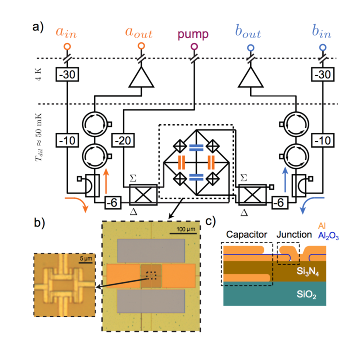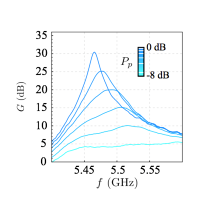Section: New Results
Wideband Josephson mixer
Participants: B. Huard and F. Mallet.
The results of this section were published in [22] .
For nearly a decade, the superconducting circuits community develops microwave amplifiers in the quantum regime, i.e. adding only a noise comparable to the vacuum fluctuations of the signal. We participated in this effort in 2012 [107] by adding frequency tunability to the only non-degenerate existing amplifier: the Josephson Parametric Converter (JPC) invented by the group of Michel Devoret at Yale.
However, this amplifier showed the defect of being limited to a few MHz bandwidth for a gain of 20 dB and a dynamic range (maximum input power before changing the gain) capable of amplifying signals typical of circuit-QED. We conducted a theoretical study to understand the various constraints involved in the manufacture of such an amplifier. This study has allowed us to make the first lumped element version of the JPC with bandwidth only limited by the mismatch between the characteristic impedance of the resonators and that of the transmission line.
|
|
Finally we have measured the quantum efficiency of this amplifier and obtained almost 70, which means that only 30 of the noise power observed at the end of line comes from technical noise while 70 is the signal, including quantum noise.




